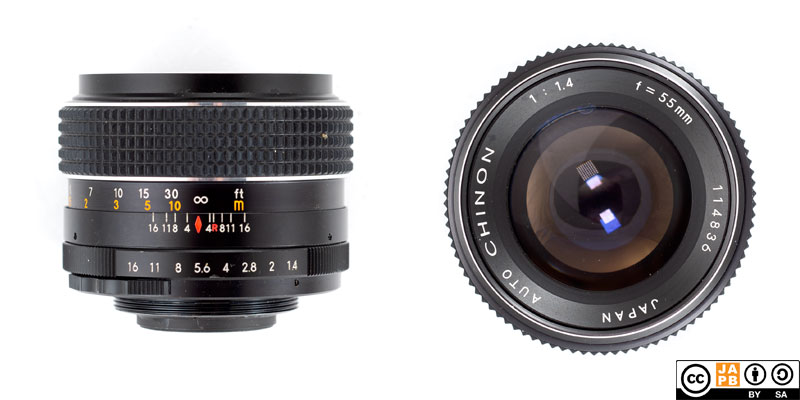Pekka Buttler, 03/2023

Specifications
The table below summarises the lens’ key specifications (measurements based on pictured sample):
| Brand: | Chinon | Lens name | Auto 1:1.4 f=55mm |
| Focal length(s) 1 | 55 mm | Angle-of-view 2 | 42° |
| Maximum Aperture | f/1.4 | In Production | late 1960s – ≈ 1975 |
| Lens mount | m42 | Subfamily (if applicable) | –– |
| Length 3 | 48,3 mm | Diameter 4 | 66,5 mm |
| Filter ring diameter | 55 mm | Weight | 299 grams |
| Lens element count | 7 | Lens group count | 6 |
| Aperture blades (S/R/C) 5 | 6 S | Focus throw | ≈300 ° |
| Minimum focusing distance | 50 cm | Maximum magnification | 1:6,9 |
| Has manual aperture ring | YES | Has Manual focus ring | YES |
| Aperture mechanism type | Automatic /manual | Aperture click stops 6 | 1.4•2•2.8•4.•5.6•8•11-16 |
Further notes:
• Alike many off-brand m42-mount 55 mm f/1.4 lenses, this too is a rebranded sample of the legendary Tomioka 55 f/1.4.
• Being a m42 auto aperture lens, it has a M/A aperture mechanism switch and a pin in the mount used to facilitate aperture automation.
• Tomioka had considerable success with its 55 mm f/1.4 lens, and it remained in production for a long time (and was sold under more names than will be ever collated). During that time, it progressed through a number of ergonomic redesigns – from metal scalloped focus rings, over metal diamond-patterned focus rings, to faux leather and other rubber focus rings [this sample]. As Chinon offered m42 cameras and lenses for a long time, many of these ergonomic variants are available under the Chinon brand.
Chinon company profile
Chinon is known to still photographers as one of the more advanced 2nd tier Japanese cameramakers. From 1971 to the late 1980s Chinon was known to enthusiast photographers the world over for combining technological advancements in cost-effective cameras bodies. See more details in the Chinon company profile.
Adapting
If you want to natively mount this lens you need to find a functioning m42 mount film camera. Luckily that should be relatively easy as m42 bodies were produced in their millions and most of them lack features that are especially likely to have deteriorated to the point of making the entire camera inoperable.
Adapting this lens to a mirrorless, full-frame digital camera is a breeze thanks to the lens having full manual controls (aperture ring, focus ring). You simply need a dumb adapter from m42 to your mirrorless system (And set the lens in manual mode to be sure the aperture works as you intend).
Due to the medium flange focal distance used by the m42 mount (45,46 mm), whether you can adapt this lens to dSLR/SLR mounts depends on which dSLR mount: Canon EF, Four Thirds, Minolta/Sony A and Pentax K can mount m42 lenses using a simple adapter ring. Nikon F on the other hand is not as problem-free, and – to retain anything near infinity focus – the adapter will necessitate corrective optics. In all cases, your camera will work only in stop-down metering.
Footnotes
- Focal length is (unless stated otherwise) given in absolute terms (not in Full-frame equivalent), and according to the manufacturer’s naming practice (which does not always reflect the lens’ actual field of view). For an understanding of whether the lens is wide/tele, see ‘Angle-of-view’. ↩︎
- Picture angle is given in degrees and concerns the diagonal picture angle. Rule of thumb:
> 90 ° ==> Ultra-wide-angle
70–90 ° ==> Wide-angle
50–70 ° ==> Moderate wide-angle
40–50 ° ==> ‘Standard’ or ‘normal’ lens
20–40 ° ==> Short tele lens
10-20 ° ==> Tele lens
5-10 ° ==> Long tele lens
< 5 ° ==> Ultra-tele lens ↩︎ - Length is given from the mount flange to the front of lens at infinity. Measured unless stated otherwise. ↩︎
- Diameter excludes protrusions such as rabbit ears or stop-down levers. Measured unless stated otherwise. ↩︎
- S=straight; R=rounded; C=(almost)circular at all apertures. ↩︎
- Numbers equal aperture values on aperture ring; • intermediate click; – no intermediate click. ↩︎